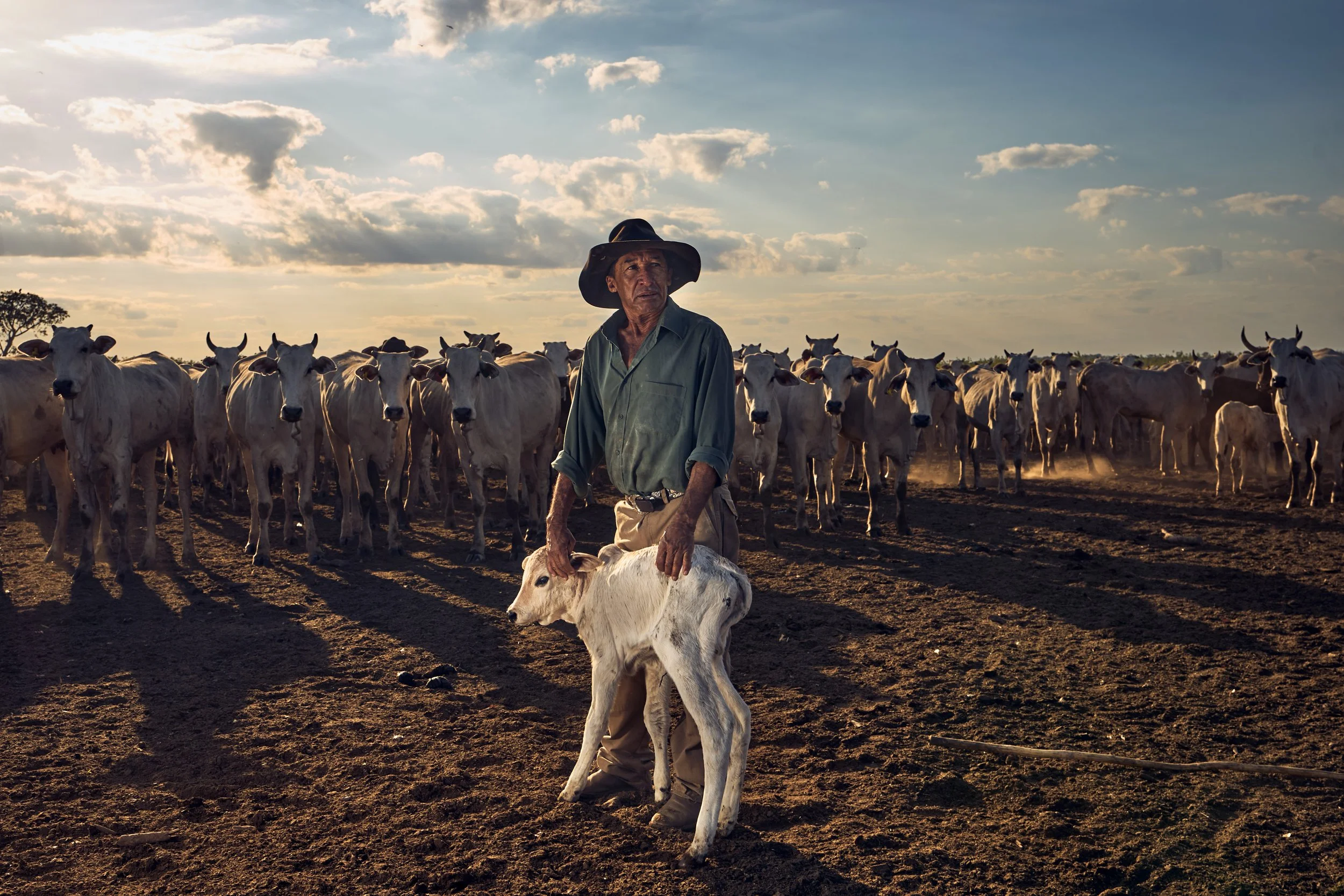
DRYING PANTANAL
FROM FLOODPLAINS TO FIRE AND RANCHING
Pantanal wetlands, Mato Grosso, Brazil
To thrive in the Pantanal’s increasingly harsh conditions, cattle must be exceptionally resilient. At Ressaca Ranch, breeders focus on genetic improvement, selectively crossing cows to enhance key traits that ensure both survival and market value. These include heat and drought resistance, disease resilience, maternal ability, growth performance, and carcass quality—factors that influence tenderness, fat content, and overall meat production. As water recedes and temperatures rise, these adaptations are crucial for sustaining cattle ranching in the world's largest tropical wetland.
Cow embryos in a lab where in vitro fertilization is done / Cow calf being treated by farm workers
The ranch where Eufragio Gonçalves Neto works depends largely on the Pantanal’s natural cycles to provide food and water for the cattle. But during the dry season, as wildfires intensify, the ranch comes under immense pressure. With pastures turning to ash and water sources dwindling, the animals struggle—losing weight and becoming more vulnerable to disease.
But what may be an opportunity for large ranches adapting their herds to harsher conditions presents a different reality for small-scale ranchers. These families depend on the natural cycles of the Pantanal, allowing their cattle to roam freely in search of water and pasture. As droughts intensify and wildfires spread, the loss of wetlands threatens their way of life.
In the nursery, calves receive specialized care to boost their immunity and prevent disease, ensuring they grow strong enough to withstand the Pantanal’s challenging conditions.
The world's largest tropical wetland and once a vast mosaic of flooded plains, the Pantanal, is drying up in an existential fight for survival. Located in the Brazilian Mato Grosso do Sul state and occupying an area equivalent to the combined size of Belgium, Switzerland, Portugal, and the Netherlands, over the last four decades it has suffered vast wildfires that have devastated 199 million hectares in Brazil. Following two consecutive years of severe drought, in 2020, over 26% of Pantanal’s landscape was scorched, facing its worst disaster in history. Scientists called it an apocalypse: flames engulfed centuries-old trees, and an estimated 17 million vertebrates perished in the inferno.
For centuries, traditional cattle ranching coexisted with natural cycles of the Pantanal, living in harmony with flooding and drying, and ranchers pastured cattle free in native grasses without a severe impact on the environment. Things have changed, though. Over the last decades, the increase of global beef meat demand combined with changing rain regimes and drying, have made cattle ranching a cause for deforestation and degradation, not harmony.
Pantanal vast wetland is under tension today as persistent droughts become extended, and rich grassland cannot reappear after fires. In adjacent biomes, including Cerrado and the Amazon rainforest, expansion of agribusiness and deforestation continues to perturb the water cycle, depleting the Pantanal of its rains, dangerously breaking its fragile balance.
As this habitat shrinks dramatically, the same industry that shaped it for centuries is being pushed well beyond its limit of sustainability. Unless urgent intervention comes before it is too late, the drying Pantanal will become a shadow of its past, a withered, lifeless plain in which neither cattle nor wildlife can survive.
Traditional cattle ranching has shaped life in the Pantanal for centuries, but in recent decades, it has become increasingly difficult to sustain. Since 1990, the Brazilian portion of this vast wetland has lost nearly 74% of its surface water, driven by agricultural irrigation, deforestation, and climate change. Compounding this crisis, criminal wildfires ravage the landscape, accelerating the region’s decline. As water disappears and flames rise, the Pantanal teeters on the brink of an uncertain future.
With a drying Pantanal, moving cattle creates dense cluds of dust, harmful to the health of the herd and the workers.
At Ressaca Ranch, organic waste from the herds is repurposed as natural fertilizer to sustain the crops grown to feed the cattle.
Workers load cattle feed into large bags, preparing it for transport across different areas of the ranch to ensure the herds are nourished
As deforestation in the Amazon and Cerrado biomes continues to rise, changing rain cycles threaten the Pantanal's ability to receive enough water. In 2020, wildfires devastated the region, causing the loss of 17 million vertebrates.
A layer of ash blankets the Pantanal wetlands, the charred remains of trees and plants lost to wildfire. While climate change deniers claim that the rains will turn the region green again, this overlooks a deeper reality—dead trees and lost biodiversity won’t return. Each fire weakens the ecosystem, paving the way for more pastures to replace what was once a thriving wilderness.
A firefighting plane soars over the blazing Pantanal, preparing to release a torrent of water in an attempt to contain the advancing wildfires.

















